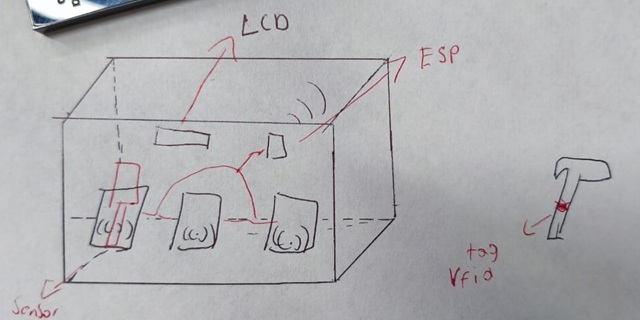Possible final project
The project consists of developing a toolbox with an RFID reader that registers when a tool is taken or returned. The system will be controlled by an ESP32 and will use passive RFID tags on each tool. The data of the tools being taken or returned will be sent to a receiving device to allow real-time tracking and inventory management of the toolbox.
Sketch
Click on the image to switch between the two versions:

Sketch 1: System using three individual RFID readers.
These sketches represent different configurations of the RFID tracking system. Sketch 1 uses three individual RFID readers to detect tools, while Sketch 2 employs a single RFID antenna for broader detection.
The idea
The main goal of this project is to facilitate tool tracking within a toolbox, ensuring that users know exactly when a tool is taken or returned. This system will help manage the inventory of tools efficiently and prevent loss or misplacement.
The system will work autonomously, using an RFID reader to detect tools as they are removed or placed back. The collected data will be sent to a platform for real-time monitoring.
Additionally, an Excel file will be automatically generated to keep track of inventory, logging which tools have been taken, returned, and their timestamps. This will provide a detailed and accessible record of the toolbox status.
Brief project description and users
This project is designed for workshops, laboratories, and makerspaces that need an efficient tool tracking system. The toolbox with RFID technology ensures that every tool movement is recorded in real-time, allowing users and administrators to monitor tool usage and prevent losses. The system is particularly useful for shared workspaces where tools are frequently borrowed and returned.
Comparison of options
The project considers two primary approaches for tool detection:
- Using multiple RFID readers: Each tool slot in the toolbox is equipped with an individual RFID reader, providing precise detection but increasing hardware costs and complexity.
- Using a single RFID antenna: A larger antenna scans the entire toolbox at once, simplifying the system but potentially reducing detection accuracy.
The choice between these two methods depends on the specific needs of the user, balancing accuracy, cost, and ease of implementation.
Required Components:
- Toolbox: Designed to house the RFID system and tools.
- RFID-RC522 readers (for Sketch 1) or a single RFID antenna (for Sketch 2).
- Passive RFID tags attached to tools.
- ESP32 to control the system.
- LCD screen (optional) for real-time status display.
- Buzzer/LED for tool detection alerts.
- SD card module (optional) to store historical logs.
- Wireless communication via Wi-Fi or Bluetooth.